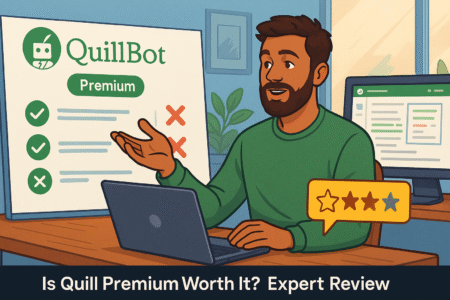Table of Contents
Are you wondering how to make a blog for money? Do you dream of turning your passion for writing into a profitable business?
This guide will take you through 7 simple steps to create a blog that not only attracts readers but also generates income. Let’s dive into the essentials of blogging for profit.
1. Choose A Profitable Blogging Niche With Demand
Choosing a profitable blogging niche is the first step in how to make a blog for money. A focused niche allows you to attract a specific audience, establish authority, and unlock monetization opportunities while building a sustainable blogging career.
Identify Your Passions And Skills For Blogging Success
Start by listing topics you’re passionate about or have expertise in. A blog fueled by genuine interest is easier to maintain and inspires better content. Ask yourself, “What can I talk about for hours without getting bored?”
Passion keeps your writing authentic, making it easier to connect with readers. Skills, on the other hand, establish credibility and help create content that solves problems effectively. Both are critical for sustained blogging success.
Your unique combination of passions and skills helps you stand out in a crowded niche. For instance, if you love cooking and have professional experience as a chef, a blog offering advanced recipes or cooking hacks could work well.
When your content reflects your enthusiasm and expertise, readers trust your advice. This trust is invaluable in blogging and serves as the foundation for monetizing your content effectively.
I recommend brainstorming topics you love and listing areas where you’re knowledgeable. This step will clarify niches that align with both your interests and market needs.
Analyze Market Demand And Trends In Blogging Niches
Once you have potential niche ideas, research their popularity. Use tools like Google Trends and BuzzSumo to gauge interest. High demand often correlates with better monetization potential for your blog.
Pay attention to seasonal trends in your niche. For example, fitness-related niches spike in popularity around New Year’s, while gardening blogs thrive in spring. Planning your content around trends boosts traffic.
Explore niche-specific forums and social media platforms to understand what people are searching for. These communities reveal pain points, popular topics, and potential keywords for your content strategy.
I suggest picking niches with consistent demand rather than fleeting trends. Evergreen niches, like personal finance or health, provide long-term traffic and income opportunities.
Look for niches with a balance of demand and manageable competition. A niche with lots of interest but limited high-quality content can be a goldmine for bloggers.
Research Competitor Blogs For Monetization Strategies
Study successful blogs in your niche to identify what works. Pay attention to their content, design, and monetization methods. This research offers valuable insights into turning your blog into a money-making machine.
Competitor blogs reveal gaps you can fill. For example, if popular blogs lack detailed guides, you can offer in-depth tutorials to attract their audience. Filling gaps helps establish authority.
Take note of their monetization strategies. Common ones include affiliate marketing, display ads, and selling digital products. Use this information to build a revenue plan for your blog.
I advise looking for inspiration, not imitation. Understand what your competitors do well, then innovate to make your blog unique and memorable to readers.
Check their audience engagement through comments, shares, or likes. Engaged readers indicate a thriving niche with income potential. It’s a sign you’re on the right track.
Select A Niche That Combines Passion And Profit Potential
Combine your research and brainstorming to finalize a niche that aligns with your passion and has monetization potential. A good niche fuels creativity and brings financial rewards.
I suggest evaluating your shortlisted niches based on three factors: interest, expertise, and income potential. Each factor plays a role in long-term blogging success.
Income potential comes from niche-specific monetization. For example, tech blogs thrive on affiliate marketing, while lifestyle blogs often sell sponsored content. Match income strategies to your skills.
Avoid niches with overly broad audiences, as they make it harder to stand out. Focused niches, like vegan baking or minimalist travel, help you build a loyal reader base.
When your passion meets market demand, blogging becomes both enjoyable and profitable. This alignment ensures you stay motivated to consistently deliver quality content.
2. Create A Catchy Blog Name And Buy A Domain

Creating a catchy blog name is essential for standing out in how to make a blog for money. A memorable name builds brand recognition, makes your blog easy to find, and sets the tone for your niche.
Brainstorm Blog Name Ideas That Reflect Your Niche
Start with brainstorming words or phrases related to your niche. Aim for something creative, easy to spell, and relevant to your target audience. For example, “SavvySipper” for a coffee blog.
A name that resonates with your audience evokes curiosity and encourages clicks. Think about your blog’s purpose and mission, and let it inspire name ideas.
Avoid names that are too generic or hard to remember. Unique and descriptive names stick in readers’ minds, increasing brand loyalty over time.
Test your ideas with friends or colleagues to see which ones stand out. Feedback from others often highlights overlooked strengths or weaknesses in your options.
I suggest using free online tools like NameMesh or Panabee for inspiration. These tools generate creative blog name ideas based on keywords from your niche.
Use Domain Tools To Check Name Availability
Once you finalize a name, check its availability as a domain. A matching domain strengthens your brand and makes your blog easier to find online.
Tools like Namecheap and GoDaddy help you verify domain availability in seconds. These platforms also suggest alternative names if your first choice is taken.
Look for domains ending in .com, as they’re more recognizable and trusted. If unavailable, extensions like .net or .blog can work, depending on your niche.
I recommend acting quickly if your chosen domain is available. Popular names disappear fast, and securing your domain early prevents disappointment.
Avoid overly long or complex domain names. A short, memorable domain simplifies marketing and improves user experience, keeping your audience engaged.
Purchase A Domain And Hosting Plan For Your Blog
After securing a name, buy your domain from a trusted provider. Many hosting services, like Bluehost or Hostinger, offer domain registration bundled with hosting plans.
Choose a reliable hosting provider that ensures fast loading speeds and minimal downtime. A well-hosted blog enhances user experience and search rankings.
I suggest selecting hosting plans with scalable options. As your blog grows, you’ll need more storage and bandwidth. Scalable plans save you from switching providers later.
A hosting plan with excellent customer support is a must. When technical issues arise, timely assistance ensures your blog stays online and operational.
Pay attention to reviews before purchasing. Hosting providers with positive feedback from bloggers offer the best value for your money and peace of mind.
Optimize Blog Name For Branding And SEO
Ensure your blog name contains relevant keywords if possible. A keyword-rich name helps search engines understand your blog’s niche, improving visibility.
Your name should reflect your blog’s personality. For example, a fitness blog might use energetic or motivational terms, while a tech blog opts for sleek, modern language.
I recommend designing a matching logo and branding elements to solidify your blog’s identity. Consistent branding across your site and social media builds trust.
Use your blog name in promotional content, social media handles, and email campaigns. This consistency enhances recall and builds a strong online presence.
When your blog name is optimized for SEO and branding, it creates a professional image that attracts readers and advertisers alike. This foundation is key to long-term success.
3. Set Up Your Blog On A Reliable Hosting Platform
Setting up your blog on a reliable hosting platform is essential for ensuring it performs well and delivers a seamless experience to visitors. A trustworthy hosting service enhances your blog’s speed, security, and scalability, which are vital for success.
Choose The Best Hosting Provider For Your Blog
When choosing a hosting provider, focus on speed, reliability, and support. These factors directly affect your blog’s performance and the user experience, making them non-negotiable for success.
A provider offering fast loading speeds helps improve your search rankings. I recommend checking reviews for uptime guarantees and customer satisfaction before making a decision.
Scalability is another key factor. As your blog grows, you may need more resources. Choosing a provider with flexible plans ensures you’re prepared for future expansion.
Look for features like automatic backups, SSL certificates, and advanced security measures. These services protect your blog from downtime, data loss, and hacking threats.
Customer support is vital. I suggest selecting a provider with 24/7 assistance to quickly resolve technical issues. This support keeps your blog running smoothly, even during challenges.
Install WordPress Or Similar Blogging Platform
WordPress is a popular blogging platform because it’s versatile, beginner-friendly, and feature-rich. Installing it on your hosting platform takes only a few steps.
Most hosting providers offer one-click WordPress installations. This feature simplifies setup, saving you time and effort. Look for this option when choosing your provider.
WordPress supports countless plugins and themes, allowing you to customize your blog easily. Whether you’re a beginner or an advanced user, its flexibility makes it a great choice.
If WordPress isn’t your preference, alternatives like Wix or Squarespace offer user-friendly interfaces. These platforms might suit you better if you prefer drag-and-drop tools.
I recommend starting with WordPress unless your needs are unique. Its vast community ensures you’ll find tutorials, plugins, and support to help you build a successful blog.
Configure Hosting Settings For Speed And Security
After installation, configure your hosting settings to maximize speed and security. This step ensures a smooth experience for readers and protects your data.
Enable caching on your hosting platform to improve load times. Faster websites enhance user satisfaction and are more likely to rank well in search engines.
Install an SSL certificate to secure your blog. SSL encrypts data and gives your site the padlock icon, increasing reader trust. Many hosting providers include SSL for free.
Regularly update your platform, plugins, and themes to prevent vulnerabilities. I advise scheduling automatic updates to avoid missing critical patches.
Use strong passwords and enable two-factor authentication. These steps add an extra layer of security, protecting your blog from unauthorized access.
Use A User-Friendly Blog Theme To Attract Visitors
A user-friendly blog theme enhances your blog’s appearance and usability. Choose a design that reflects your niche and provides a great experience for visitors.
Responsive themes ensure your blog looks good on all devices. I recommend prioritizing mobile-friendly designs, as many readers will access your blog on their phones.
Minimalistic themes load faster, reducing bounce rates. Visitors are more likely to stay and explore your blog when pages load quickly and smoothly.
Customizable themes let you add personal touches, like branding and color schemes. These features help your blog stand out while staying true to your niche.
I suggest testing your theme’s navigation. Clear menus and well-organized layouts make it easier for readers to find content, keeping them engaged and returning for more.
4. Craft High-Quality Content That Engages Readers

Crafting high-quality content is at the heart of how to make a blog for money. Valuable, engaging content attracts readers, builds trust, and increases the likelihood of monetization through various strategies.
Write Engaging Blog Posts Around Reader Interests
To write engaging posts, focus on solving your audience’s problems or answering their questions. Start with topics that resonate with their interests and needs.
Conduct research to understand what readers in your niche are searching for. Tools like Google Trends or BuzzSumo help identify trending topics that attract traffic.
I suggest writing in a conversational tone that makes readers feel like they’re speaking to a friend. Relatability builds trust and encourages readers to engage with your content.
Break your content into digestible sections with clear headings. This structure keeps readers interested and improves your blog’s readability and search ranking.
Include actionable advice in every post. Readers appreciate tips they can apply immediately, which keeps them coming back for more helpful insights.
Optimize Content For SEO Using Target Keywords
SEO optimization is crucial for visibility. Use the focus keyword naturally in your content, title, and meta description to help search engines understand your topic.
Include the keyword in the first 100 words and in at least one subheading. I recommend writing naturally to avoid keyword stuffing, which can harm your rankings.
Use synonyms and related terms to diversify your keyword usage. This approach improves your content’s readability and ensures it appeals to search algorithms.
Internal linking connects your posts, helping readers discover related content. This strategy increases session time and improves your blog’s SEO performance.
Include a call-to-action encouraging readers to share your posts. Social shares signal quality to search engines, improving your blog’s authority and rankings.
Incorporate Visuals Like Images And Videos
Visuals enhance your content’s appeal and boost reader engagement. Use high-quality images, infographics, and videos to complement your text and make it more engaging.
I suggest adding visuals that explain complex ideas. For example, a chart or infographic can simplify data-heavy sections, making them easier for readers to understand.
Videos provide an interactive experience that keeps readers on your page longer. Tutorials, interviews, or behind-the-scenes clips add variety and interest to your content.
Optimize your visuals for fast loading. Compress images and embed videos to ensure they don’t slow down your site, as speed impacts SEO and user satisfaction.
Include alt text for all visuals. This improves accessibility for readers and boosts your blog’s SEO, as search engines rely on alt text to understand images.
Maintain A Consistent Posting Schedule
Consistency is key to building a loyal audience. A regular posting schedule keeps readers engaged and encourages them to return for fresh content.
Start with a manageable frequency, such as one post per week. I recommend maintaining quality over quantity to ensure every post provides value.
Use an editorial calendar to plan your content. Scheduling ahead reduces stress and helps you stay consistent, even during busy periods.
Engage with readers through comments and social media. Responding to their feedback creates a connection, encouraging them to become regular visitors.
Analyze your posting schedule’s impact using analytics tools. Monitor traffic patterns to identify the best times to publish and refine your strategy accordingly.
5. Drive Traffic With Smart Promotion Techniques
Driving traffic is crucial for how to make a blog for money. Smart promotion strategies attract readers, improve engagement, and create opportunities for monetization. A targeted approach ensures that your efforts yield measurable results and build a loyal audience.
Use Social Media To Promote Blog Content Effectively
Social media is a powerful tool for sharing your blog posts with a wider audience. Platforms like Instagram, Twitter, and LinkedIn connect you with readers who are interested in your niche.
Create engaging posts tailored to each platform. For example, use visually appealing images for Instagram and short, snappy updates for Twitter. Tailored content performs better and increases engagement.
Consistency matters in social media promotion. I recommend posting regularly and scheduling your updates to keep your audience engaged without overwhelming them.
Engage with followers through comments and direct messages. This interaction builds relationships and encourages readers to visit your blog, helping you create a loyal audience.
Experiment with paid ads to amplify reach. Promoting a high-quality blog post on social media can drive targeted traffic, improving your blog’s visibility and audience size.
Leverage Email Marketing For Repeat Blog Visitors
Email marketing is an excellent way to nurture relationships with your audience and keep them returning to your blog. A well-curated email list offers consistent traffic and engagement.
Create a lead magnet, like a free guide or checklist, to encourage visitors to subscribe. Valuable content incentivizes sign-ups and starts building trust with your audience.
I suggest segmenting your email list based on interests. Tailored emails feel personal and are more likely to be opened and clicked, improving your blog’s traffic.
Share your latest blog posts with your email subscribers. Highlight the value of the content in your subject line to entice them to click through and read more.
Analyze email performance to refine your strategy. Open rates, click-through rates, and engagement data help you create campaigns that resonate with your audience.
Collaborate With Influencers And Fellow Bloggers
Collaboration amplifies your reach by exposing your blog to a new audience. Working with influencers or bloggers in your niche is a strategic way to grow traffic.
Identify influencers who share your target audience. Partnering with someone who aligns with your niche ensures their followers are genuinely interested in your content.
Guest posting on established blogs is another effective method. Sharing your expertise on their platform introduces you to a wider audience and builds credibility.
I recommend co-creating content, such as interviews or collaborative blog posts. This approach is engaging and leverages both audiences for maximum impact.
Promote your collaborations on your channels as well. Highlighting the partnership increases visibility and shows your audience that you’re active in the community.
Engage In Forum Discussions To Gain New Readers
Forums and online communities offer direct access to potential readers. Participating in relevant discussions helps you connect with an audience actively seeking information in your niche.
Share valuable insights on platforms like Reddit or Quora. Answering questions thoughtfully demonstrates expertise and encourages users to visit your blog for more in-depth content.
Include your blog link in your forum profile or posts when appropriate. I suggest avoiding overly promotional tactics—focus on being helpful to build trust.
Regular participation increases your visibility. I recommend setting aside time each week to engage with the community, strengthening your presence and driving traffic.
Build relationships with forum members. Genuine connections lead to long-term readers who are more likely to engage with and share your content.
6. Monetize Your Blog With Proven Strategies

Learning to monetize your blog is a critical step in how to make a blog for money. Proven strategies, like affiliate marketing and sponsored content, can turn your blog into a reliable income stream when applied effectively.
Explore Affiliate Marketing For Passive Income
Affiliate marketing allows you to earn commissions by promoting products or services. It’s a passive income method that works well with informative or review-based content.
Choose affiliate programs relevant to your niche. For instance, tech bloggers can promote gadgets, while lifestyle bloggers might focus on home decor or beauty products.
I recommend being transparent with your readers about affiliate links. Honesty builds trust and ensures your audience feels comfortable clicking on your recommendations.
Write genuine reviews or tutorials featuring affiliate products. Detailed, helpful content encourages readers to take action, increasing your earnings.
Track affiliate performance using analytics tools. Understanding which links drive sales helps you optimize future campaigns and increase revenue.
Use Google AdSense To Generate Ad Revenue
Adsterra places targeted ads on your blog, earning you money whenever visitors click on them. It’s an easy way to monetize content with consistent traffic.
Focus on growing your traffic before applying for Adsterra. I suggest reaching a stable audience size to make ad placements worthwhile and profitable.
Position ads strategically to maintain a good user experience. Avoid intrusive placements that disrupt the flow of your blog, as they may deter readers.
Experiment with ad types and placements to find the best-performing combinations. Analyze click-through rates to determine which layouts generate the most revenue.
Combine Adsterra with other monetization methods for diversification. A balanced approach ensures consistent income even if one strategy underperforms.
Offer Digital Products Like Ebooks And Courses
Digital products are a scalable income source. Creating ebooks or courses that solve problems in your niche establishes authority and generates revenue.
Choose topics your audience is eager to learn about. I recommend surveying readers to identify their pain points and tailor your products accordingly.
Deliver high-quality content that exceeds expectations. Well-researched ebooks or professionally crafted courses justify their price and attract positive reviews.
Promote your products through your blog and email list. Highlight the benefits and use testimonials to build credibility and encourage purchases.
I suggest pricing your products competitively. Offering an introductory discount can drive initial sales and create buzz around your offerings.
Partner With Brands For Sponsored Blog Content
Sponsored content involves working with brands to create blog posts that promote their products or services. It’s a profitable option for established blogs with loyal audiences.
Reach out to brands that align with your niche. I recommend presenting a professional media kit showcasing your blog’s traffic, audience demographics, and engagement.
Create authentic, engaging content that highlights the brand’s value. Readers appreciate honest reviews and recommendations over hard-selling tactics.
Disclose sponsored partnerships to maintain transparency. Honesty builds trust and ensures your audience remains engaged with your content.
Foster long-term relationships with brands. Consistent collaborations provide steady income and establish your blog as a trusted voice in the industry.
7. Track Performance And Continuously Optimize Blog
Monitoring your blog’s performance is vital for long-term success in how to make a blog for money. Regular optimization ensures you adapt to changing trends and keep delivering value to your audience.
Use Analytics Tools To Monitor Blog Traffic
Analytics tools like Google Analytics provide insights into your blog’s performance. Monitoring traffic helps you understand what’s working and where improvements are needed.
Track metrics like page views, bounce rate, and session duration. These indicators reveal how readers interact with your content and where adjustments are needed.
I recommend setting specific goals, such as increasing monthly traffic by 10%. Clear objectives help you focus your efforts and measure success effectively.
Analyze traffic sources to identify the most effective promotion channels. Focusing on high-performing platforms maximizes your time and resources.
Use data to refine your content strategy. For example, if tutorials perform better than reviews, prioritize similar topics to keep your audience engaged.
Analyze Audience Behavior For Content Improvements
Understanding your audience’s preferences helps you tailor content to their needs. Use heatmaps and behavior analytics tools to see how visitors interact with your site.
Focus on high-performing pages and replicate their structure or tone. These insights guide you in creating more of what your audience loves.
Pay attention to underperforming content. I suggest updating or repurposing these posts to make them more relevant and engaging for readers.
Engage with your audience through comments or polls. Direct feedback provides valuable insights into what they want from your blog.
Incorporate user suggestions into your content strategy. Listening to your readers builds trust and strengthens their loyalty to your blog.
Test New Monetization Methods To Boost Revenue
Experimenting with different monetization methods helps you find the most profitable options for your blog. Testing ensures you’re maximizing your income potential.
Introduce new strategies gradually, such as premium memberships or paid webinars. I recommend monitoring results to determine their effectiveness before expanding further.
Track earnings from each method to identify top performers. This data helps you focus on strategies that yield the highest returns.
Diversify your income sources to reduce reliance on a single stream. A balanced approach provides stability even if one method underperforms.
Stay creative and adaptable. I suggest keeping an eye on emerging monetization trends to stay ahead of competitors and continuously improve your revenue.
Stay Updated On Blogging Trends And SEO Changes
Blogging trends and SEO rules evolve regularly. Staying informed helps you adapt your strategies and maintain your blog’s visibility and relevance.
Follow industry blogs, attend webinars, or join forums to learn from experts. Continuous learning keeps your skills sharp and your blog competitive.
Regularly audit your blog for outdated practices. For example, updating older posts with new SEO guidelines ensures they remain effective.
I advise experimenting with new tools and technologies, such as AI for content optimization. Innovation keeps your blog fresh and appealing to readers.
Networking with other bloggers provides valuable insights and inspiration. Sharing experiences helps you stay motivated and ahead of industry changes.






